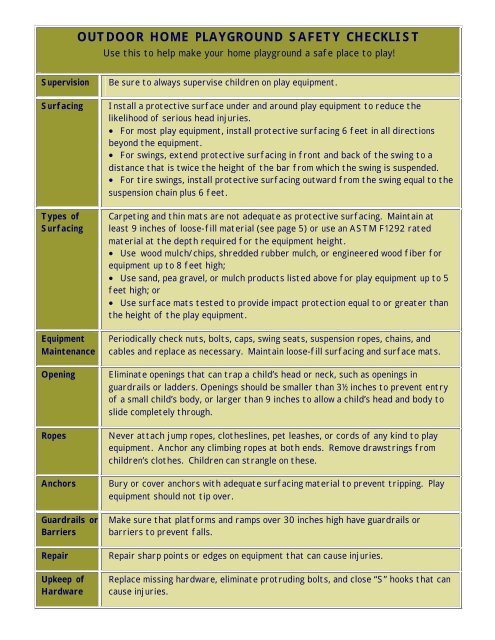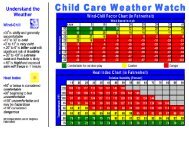Outdoor Home Playground Safety Handbook - Cultivate Safety
Outdoor Home Playground Safety Handbook - Cultivate Safety
Outdoor Home Playground Safety Handbook - Cultivate Safety
You also want an ePaper? Increase the reach of your titles
YUMPU automatically turns print PDFs into web optimized ePapers that Google loves.
OUTDOOR HOME PLAYGROUND SAFETY CHECKLIST<br />
Use this to help make your home playground a safe place to play!<br />
Supervision<br />
Surfacing<br />
Types of<br />
Surfacing<br />
Equipment<br />
Maintenance<br />
Opening<br />
Ropes<br />
Anchors<br />
Guardrails or<br />
Barriers<br />
Repair<br />
Upkeep of<br />
Hardware<br />
Be sure to always supervise children on play equipment.<br />
Install a protective surface under and around play equipment to reduce the<br />
likelihood of serious head injuries.<br />
• For most play equipment, install protective surfacing 6 feet in all directions<br />
beyond the equipment.<br />
• For swings, extend protective surfacing in front and back of the swing to a<br />
distance that is twice the height of the bar from which the swing is suspended.<br />
• For tire swings, install protective surfacing outward from the swing equal to the<br />
suspension chain plus 6 feet.<br />
Carpeting and thin mats are not adequate as protective surfacing. Maintain at<br />
least 9 inches of loose-fill material (see page 5) or use an ASTM F1292 rated<br />
material at the depth required for the equipment height.<br />
• Use wood mulch/chips, shredded rubber mulch, or engineered wood fiber for<br />
equipment up to 8 feet high;<br />
• Use sand, pea gravel, or mulch products listed above for play equipment up to 5<br />
feet high; or<br />
• Use surface mats tested to provide impact protection equal to or greater than<br />
the height of the play equipment.<br />
Periodically check nuts, bolts, caps, swing seats, suspension ropes, chains, and<br />
cables and replace as necessary. Maintain loose-fill surfacing and surface mats.<br />
Eliminate openings that can trap a child’s head or neck, such as openings in<br />
guardrails or ladders. Openings should be smaller than 3½ inches to prevent entry<br />
of a small child’s body, or larger than 9 inches to allow a child’s head and body to<br />
slide completely through.<br />
Never attach jump ropes, clotheslines, pet leashes, or cords of any kind to play<br />
equipment. Anchor any climbing ropes at both ends. Remove drawstrings from<br />
children’s clothes. Children can strangle on these.<br />
Bury or cover anchors with adequate surfacing material to prevent tripping. Play<br />
equipment should not tip over.<br />
Make sure that platforms and ramps over 30 inches high have guardrails or<br />
barriers to prevent falls.<br />
Repair sharp points or edges on equipment that can cause injuries.<br />
Replace missing hardware, eliminate protruding bolts, and close “S” hooks that can<br />
cause injuries.







